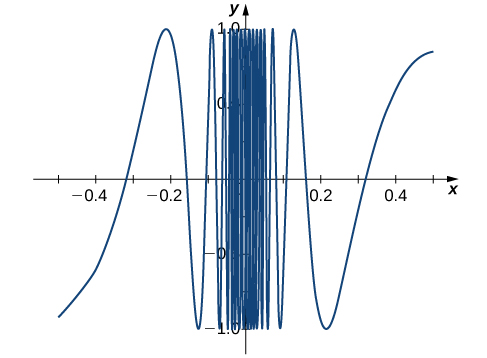| << Chapter < Page | Chapter >> Page > |
Let a be a real number and c be a constant.
We can make the following observations about these two limits.
| x | x | |||
|---|---|---|---|---|
| c | c | |||
| c | c | |||
| c | c | |||
| c | c |
Observe that for all values of x (regardless of whether they are approaching a ), the values remain constant at c . We have no choice but to conclude
As we consider the limit in the next example, keep in mind that for the limit of a function to exist at a point, the functional values must approach a single real-number value at that point. If the functional values do not approach a single value, then the limit does not exist.
Evaluate using a table of values.
[link] lists values for the function for the given values of x .
| x | x | |||
|---|---|---|---|---|
| −0.1 | 0.544021110889 | 0.1 | −0.544021110889 | |
| −0.01 | 0.50636564111 | 0.01 | −0.50636564111 | |
| −0.001 | −0.8268795405312 | 0.001 | 0.826879540532 | |
| −0.0001 | 0.305614388888 | 0.0001 | −0.305614388888 | |
| −0.00001 | −0.035748797987 | 0.00001 | 0.035748797987 | |
| −0.000001 | 0.349993504187 | 0.000001 | −0.349993504187 |
After examining the table of functional values, we can see that the y -values do not seem to approach any one single value. It appears the limit does not exist. Before drawing this conclusion, let’s take a more systematic approach. Take the following sequence of x -values approaching 0:
The corresponding y -values are
At this point we can indeed conclude that does not exist. (Mathematicians frequently abbreviate “does not exist” as DNE. Thus, we would write DNE.) The graph of is shown in [link] and it gives a clearer picture of the behavior of as x approaches 0. You can see that oscillates ever more wildly between −1 and 1 as x approaches 0.

Use a table of functional values to evaluate if possible.
does not exist.
Sometimes indicating that the limit of a function fails to exist at a point does not provide us with enough information about the behavior of the function at that particular point. To see this, we now revisit the function introduced at the beginning of the section (see [link] (b)). As we pick values of x close to 2, does not approach a single value, so the limit as x approaches 2 does not exist—that is, DNE. However, this statement alone does not give us a complete picture of the behavior of the function around the x -value 2. To provide a more accurate description, we introduce the idea of a one-sided limit . For all values to the left of 2 (or the negative side of 2), Thus, as x approaches 2 from the left, approaches −1. Mathematically, we say that the limit as x approaches 2 from the left is −1. Symbolically, we express this idea as

Notification Switch
Would you like to follow the 'Calculus volume 1' conversation and receive update notifications?